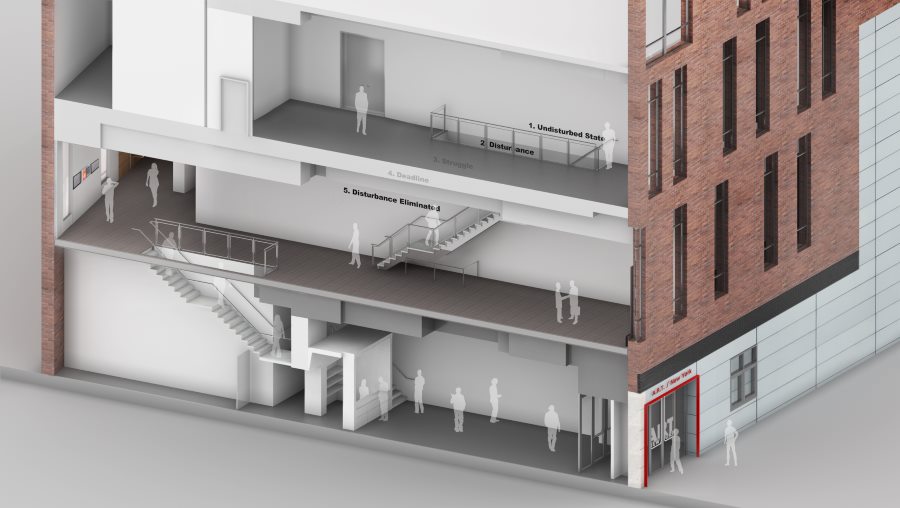NEW YORK CITY: One of the biggest challenges for any small theatre company is finding a space to perform. The problem is especially acute in New York City, where sky-high rents are often prohibitive for artists. The Alliance of Resident Theatres/New York is aiming to make that budget line a little easier for small companies with ART/New York Theatres, two affordable new performance spaces at 502 West 53rd Street.
“If you’re a company whose budget is under $1 million, doing a capital campaign is hard on the staff,” explained ART/New York executive director Virginia P. Louloudes. “And if you raise the money, managing that project is still a heavy lift, and when you get that building space, you never know what to expect.”
The space will open in Nov. 2016 with New Georges‘ production of Hilary Bettis’s Alligator, part of the Sol Project; Ma-Yi Theatre will open Michi Barall’s Matt Park Is Peer Gynt & the Norwegian Hapa Band in January 2017. Ma-Yi and New Georges are among seven pilot companies that met with ART/New York regularly to help develop the program. The other theatres in the pilot group are the Movement Theatre Company, NAATCO, New York Neo-Futurists, Pioneers Go East Collective, and Pipeline Theatre Company. Each of these companies will be able to mount a production in one of the rent-subsidized spaces within the next three seasons.
Other companies selected to stage a show during the 2017-18 season are Amas Musical Theatre, Broken Box Mime Theater, Buran Theatre, the Civilians, Dramatic Question Theatre, Houses on the Moon Theater Company, New York City Children’s Theater, One Year Lease Theater Company, the Play Company, Project Y Theatre Company, Prospect Theater Company, Target Margin Theater, Theater Breaking Through Barriers, and Transport Group Theatre Company.
Louloudes notes that New York City has lost more than 80 small theatres in the last 15 years, while more than half of ART/New York’s 370 members have a budget under $1 million. The project began when the city invited ART/New York to take part in the NYC Department of Design and Construction’s Design Excellence Program in 2008, where they met architect Toshiko Mori. The build-out of an existing warehouse began in 2008, resulting in two performance spaces: the 87-seat Jeffrey and Paul Gural Theatre and the 149-seat Mezzanine Theatre. Both spaces are flexible, and can be arranged in a variety of audience setups.
ART/New York has been raising support for a 25-year rental subsidy fund, and construction for the theatres is funded by the city of New York to the tune $16.672 million, with an additional $400,000 leadership investment from New York state. Support also came from Jeffrey and Paula Gural, the Ford Foundation, the Doris Duke Charitable Foundation, and dozens of generous foundations and individuals.
Each company applied through an online form and were evaluated by a peer panel, made up of theatres whose budgets were under $1 million but didn’t apply and theatres whose budgets were a little more than $1 million and could thus relate to the struggles of small companies, as well as facilities managers familiar with the needs of smaller companies.
“The criteria was: What is your mission? Who is your audience that you serve and how do you serve them?” Louloudes said. “We wanted to make sure that we get people who are really serving the communities that they claim to serve. We also wanted a lot of diversity among those groups.”
Companies could ask for three to eight weeks in the space, which could include a tech week but not rehearsals, as there are no rehearsal spaces in the building. They could also either specify which of the two theatres they would prefer or leave it open. Each company will receive the same rent subsidy in the space, no matter what their budget is. If the spaces are otherwise unoccupied, companies with budgets of more than $1 million can rent them with no subsidy.
While the rent cost savings may allow some of these smaller companies to grow, Louloudes notes that that is not the goal of this project.
“I don’t believe that’s growth equals success,” she said. “There are some companies who are strategically small and want to be small because the work they do is very specific, and would never work well in a proscenium stage with an audience of 800 people. It needs to be intimate. Those companies are for whom these theatres will always be there.”


